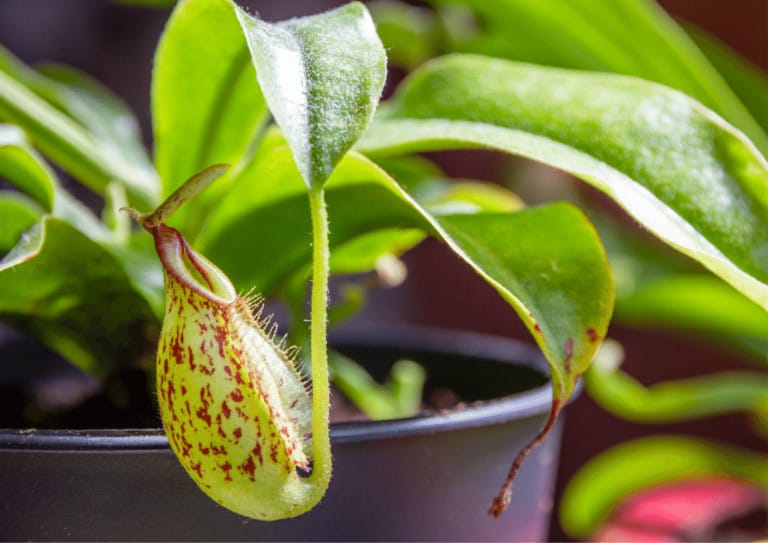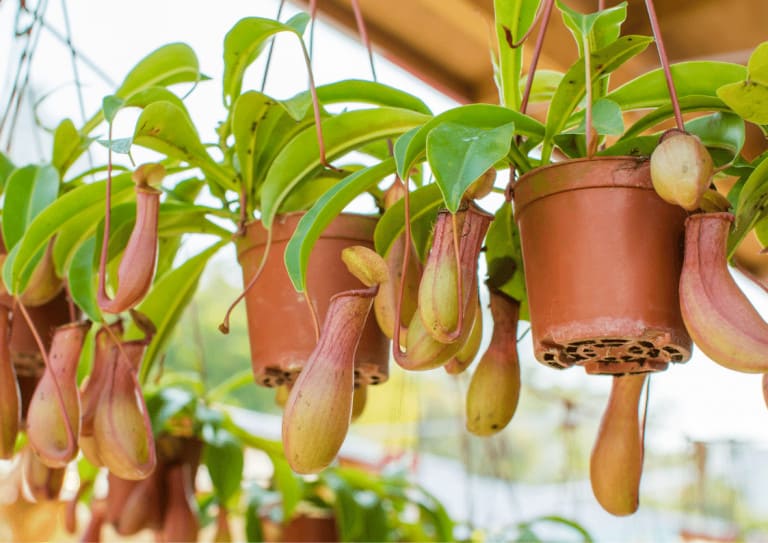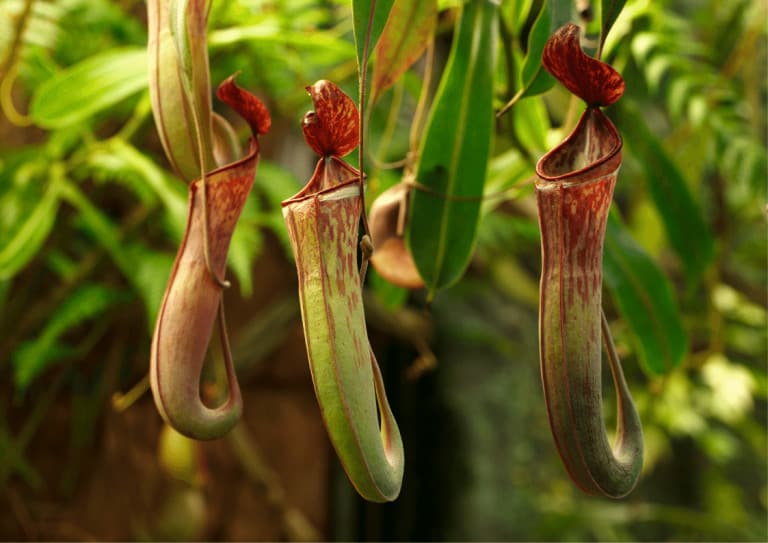How Long Does It Take Nepenthes To Grow Pitchers?
- Lakeisha Ethans
- March 31, 2022
If you buy something using the retail links in our articles, sometimes we earn a small affiliate commission. This does not impact the products we recommend.
Nepenthes plants, or pitcher plants, are renowned for their iconic pitchers. The tropical carnivorous plants are barely recognizable without them. Therefore, it can be quite disheartening to have a Nepenthes plant that doesn’t seem to grow those structures. But why is it happening, and how long do you have to wait for them to grow?
Pitcher plants take a long time to grow their pitchers, only developing them once they are fully mature and established. It can take a Nepenthes plant between five and 10 years to grow its first pitcher in the right growing conditions. In poor growth conditions, this might take even longer.
There are over 170 officially recognized Nepenthes plant species. To some degree, different species will have different lifespans and rates of growth. Still, there are enough similarities between them that the timeline remains the same, generally speaking.
This article aims to provide information on Nepenthes plants and the rate of growth you can expect from them. Some of the things we’ll cover are:
- What is the general timeline for the growth of a Nepenthes?
- What are the best growing conditions to promote the growth of Nepenthes pitchers?
- How long does it take mature Nepenthes cuttings to grow pitchers?
- What does it mean if my Nepenthes is growing tendrils but not pitchers?
In this post, we’ll examine the nature of Nepenthes plants and their growth phases, the stunning pitchers they create, and what to expect when trying to grow this genus of flora.

What is the general timeline for the growth of a Nepenthes?
Germinated Nepenthes seeds are notoriously slow growers. It can take a whopping year before even an inch of growth is seen from these seeds. In general, the seeds show some development at two months and can grow into a mature plant at around the age of two years.
Initial growth begins with the dispersal of roots, and it can be years before pitcher traps start to form at all. Once they do, juvenile pitcher traps can be seen developing as specialized leaves. These leaves will not function carnivorously until they’re fully mature. The leaf starts out flat, then progressively becomes “inflated” to create an inner chamber.
The inner chamber slowly develops further by growing flanges and secreting liquid inside. Once this stage is done, the “cap” or “lid” of the pitcher opens up. This releases the inner nectar’s scent, which attracts insects for consumption. This process may take between five and ten years, so you’ll likely see flat leaves expanding long before they finish their proper inflation at all.
Once a pitcher’s lid has opened and it has matured, climbing stems are developed by the Nepenthes plant. The vine-like stems seek light by crawling onto various structures, which also help to support the large and bulky pitchers.
A pitcher plant may live for about 20 years before it starts drying out internally, its nectar evaporating. Once it is completely dried up, it will decompose and die.
What are the best growing conditions to promote the growth of Nepenthes pitchers?
As with most plants, one of the first things to consider when growing Nepenthes plants is the amount of light that they receive. Without enough sunlight, the plant will not grow any leaves and therefore can’t develop pitchers.
Nepenthes pitchers require between three and four hours of indirect, bright sunlight per day.
Direct sunlight is not a good idea, as this can cause scorched leaves. Leaving the Nepenthes on a windowsill that doesn’t usually get direct sun exposure typically works fine. If you notice the plant beginning to shift towards the sun more and more, it’s time to increase light exposure.
Next, your Nepenthes needs a good level of humidity. After all, this is a tropical plant, meaning it prefers high levels of humidity. Dry air may prevent the growth of pitchers, and there isn’t enough moisture to promote the production of internal pitcher nectar.
You can handle this problem by misting your Nepenthes frequently, which will promote leaf inflation. Items like humidity trays or humidifiers can also be purchased and used to help to increase these levels to the correct ones. You can also make your own humidity-creating items, such as a pebble tray, to serve this purpose.
Then, consider the kind of nutrients that your Nepenthes is receiving. In most cases, these plants don’t really need supplemental fertilizer. But if your plant has been struggling to produce pitchers, a little bit of acidic fertilizer does the trick by filling any nutritional gaps.
Just an eighth of a teaspoon of this type of fertilizer, mixed with one quart of water, can give your Nepenthes enough nutrients so it can thrive. Do not use too much fertilizer, though – excessive use grows normal leaves, not pitchers, and can even prevent pitcher development.
Finally, consider the water that you’re using for your Nepenthes. If you use tap water, your plant may not be a big fan of all the additives and minerals in that source. Rainwater is your best bet when it comes to this, so collect some if you can.
Only water a Nepenthes when its potting mix has a top layer of dry soil. Avoid creating soggy or completely dry soil – balance is key! A good watering schedule allows lower soil layers to almost always be wet, mimicking some of the tropical environments that a Nepenthes is used to. Try to water the plant downwards so that its roots can absorb the moisture more easily.

How long does it take mature Nepenthes cuttings to grow pitchers?
Growing Nepenthes plants from seeds is notoriously difficult. Seeds become non-viable very quickly and growth is so slow that those who want to see some iconic pitchers quickly will prefer other methods of propagation. As a result, mature cuttings of Nepenthes plants are a more common propagation method.
These mature cuttings grow much more quickly and can begin producing pitchers about six months after being planted. They root only one or two months after their initial planting, especially when you propagate them in moss and expose them to the right growing conditions.
What does it mean if my Nepenthes is growing tendrils but not pitchers?
Nepenthes plants only grow tendrils and vines when they’re at the right age to produce pitchers. They will continue to produce these tendrils for the rest of their lives, essentially experiencing the continual growth of these appendages.
If your Nepenthes plant is not growing pitchers but has grown many tendrils, this is a bad sign. It indicates that your plant is not receiving the correct growing conditions, thus stifling its ability to grow pitchers. By right, it should have already been producing pitchers by now!
You can correct this issue by referring back to the best growing conditions to promote Nepenthes growth and health. You may also want to check your plant for any signs of pests or other issues that could be inhibiting growth.

Round up
Nepenthes plants are slow-growing plants. If you get a juvenile Nepenthes, chances are that it will take years before it starts to develop pitchers at all. The fact is that you could end up waiting up to a decade before the Nepenthes pushes forth those iconic structures. If you want faster growth, you’ll need to purchase a cutting from a mature Nepenthes.
You can improve the chances of your Nepenthes growing a pitcher more quickly by ensuring optimal growing conditions. The right humidity, light exposure, nutrients, potting mix, and watering schedule can all work together to promote better growth. If your plant continues to struggle to grow, examine these factors to see if you’re not meeting the plant’s needs accurately!

Lakeisha Ethans
Houseplant Writer
Mother to two humans and hundreds of plant babies. Lakeisha uses her 15 years of experience as a content writer to specialise in simplifying what you need to know to grow and care for all indoor plants.
Similar Posts
Pruning Your Monstera Plant: Tips for Growth and Disease Prevention
Pruning your Monstera plant can be intimidating, but it's essential for its health and appearance. Follow these simple steps to keep your Monstera thriving.
Feng Shui Plant Ideas For A Wealthy Office {Lucky Plants Only!}
Luck comes in many forms, and there are indoor plants that deal with all different elements, from love, to money, and health.



